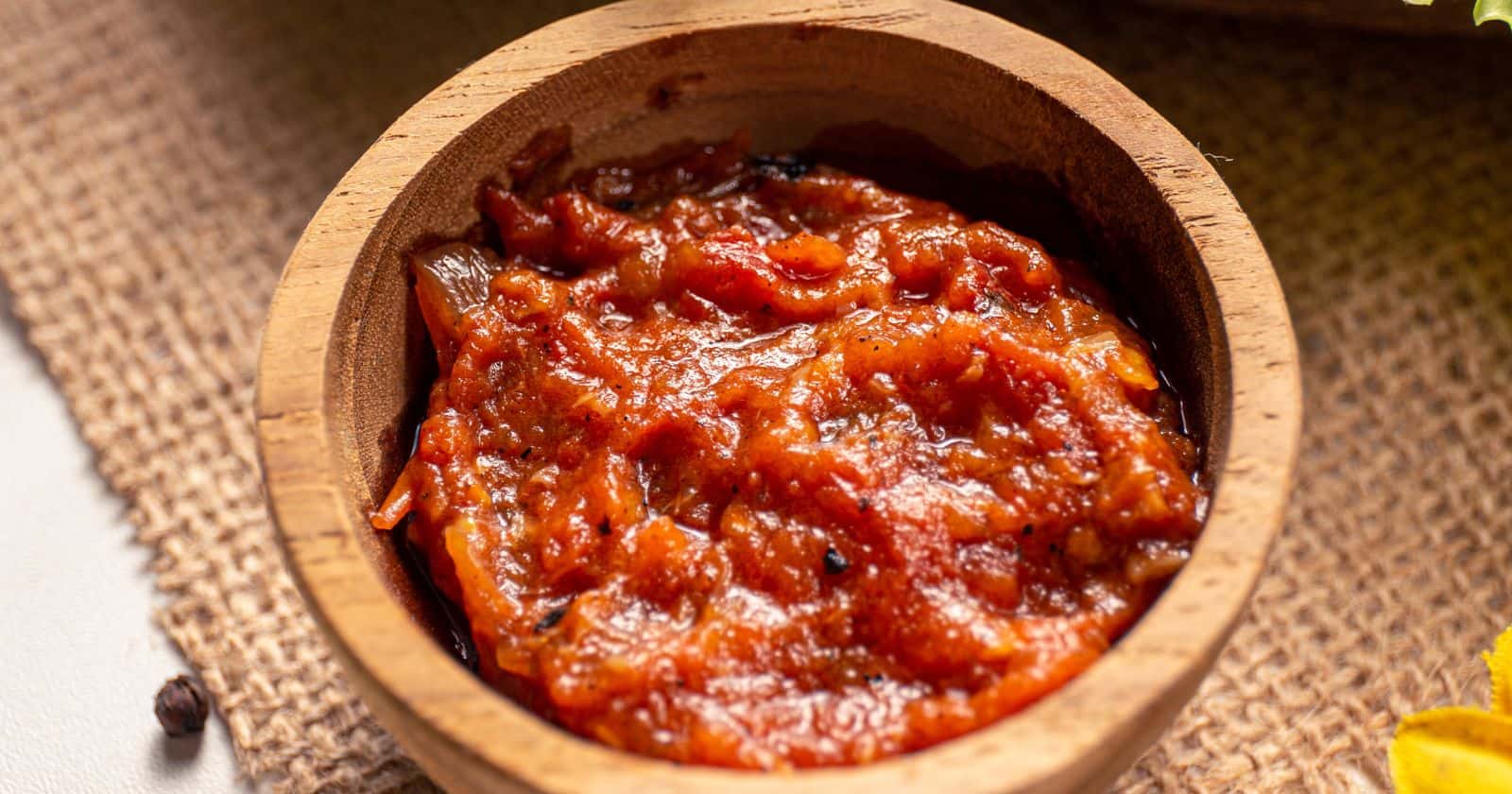Discover the secrets to keeping your sambal fresh and flavorful! Find out why sambal can be stored in the fridge, how long it will stay fresh, and alternative storage options to extend its shelf life. Don’t let your favorite chili paste go to waste – read on to learn all about preserving sambal.
Yes, sambal can be kept in the fridge for 2-3 weeks in an airtight container or jar, ensuring it remains fresh and delicious. It can even be frozen for up to 6 months if stored properly. While sambal doesn’t necessarily require refrigeration, it can help extend its shelf life and avoid any color changes. Plus, opened sambal oelek can last for about 6 months to a year in the refrigerator – that’s plenty of time to savor its spicy goodness. Store it in an airtight container to prevent drying and to avoid any unwanted flavors seeping in.
In the following sections, we will delve into alternative storage options for sambal, explore creative recipes to make your own homemade sambal chili paste, and provide expert tips on how to incorporate sambal into a variety of dishes. Whether you’re a heat-loving foodie or simply curious about maximizing the longevity of your sambal, this article has you covered.
Let’s embark on a culinary adventure together and unlock the wonders of sambal preservation.
Importance of Properly Storing Sambal in the Fridge
Properly storing sambal in the fridge is crucial in order to maintain its freshness, extend its shelf life, and ensure its safety for consumption. Here are some reasons why it is important to store sambal in the fridge:
- Prevents spoilage: Sambal is a chili sauce that is prone to spoilage due to its high moisture content and the presence of perishable ingredients like garlic and shallots. Refrigerating sambal helps to slow down the growth of microorganisms, such as bacteria and molds, that can cause spoilage. By preventing spoilage, you can enjoy sambal for a longer period of time without the risk of consuming spoiled food.
- Extends shelf life: Storing sambal in the fridge significantly extends its shelf life. When kept in an airtight container or jar, sambal can last for up to 2-3 weeks in the refrigerator. This allows you to enjoy sambal over multiple meals without having to worry about it spoiling quickly. If you want to store it for an even longer period, you can freeze sambal for up to 6 months in an airtight container.
- Maintains quality: Refrigeration helps to maintain the quality and flavor of sambal. By keeping it at a low temperature, the integrity of the ingredients is preserved, ensuring that the flavors remain intact. Additionally, refrigeration helps to preserve the texture and consistency of the sauce, preventing it from becoming watery or separating. This ensures that every spoonful of sambal you use adds a burst of flavor to your dishes.
- Safer to eat: Properly storing sambal in the fridge is essential for food safety. The cold temperature inhibits the growth of harmful bacteria that can cause foodborne illnesses. By refrigerating sambal, you significantly reduce the risk of bacterial growth and the potential for food poisoning. This is especially important if you have prepared a large batch of sambal or if you live in a warm climate where the temperature can promote the growth of bacteria.
The Best Containers for Storing Sambal in the Fridge
When it comes to storing sambal in the fridge, it’s important to choose the right container to ensure its freshness and prevent spoilage. Based on the search results, here are some of the best containers for storing sambal in the fridge:
- Glass container: According to Nomadette, sambal can be stored in a glass container to make it last longer. Glass containers are non-reactive, meaning they won’t absorb any odors or flavors from the sambal. This helps in preserving the original taste and quality of the sambal.
- Airtight container or jar: Most sources recommend storing sambal in an airtight container or jar. This prevents air and moisture from entering the container, which can lead to spoilage and mold growth. It is important to ensure that the container is tightly sealed to maintain the freshness of the sambal.
- Plastic jar: Christie at Home suggests using a plastic jar for storing sambal, especially if you plan to freeze it. Plastic jars are lightweight and durable, making them a good option for freezing sambal. They can be frozen for up to 5-6 months without affecting the taste or quality of the sambal.
- Small jar: Cook Eat World recommends transferring the sambal to a small jar before refrigerating it. This helps in keeping the sambal fresh and prevents it from going bad quickly. Using a smaller jar also minimizes the exposure of the sambal to air, helping to preserve its flavor and texture.
Benefits of Refrigerating Sambal for Shelf Life Extension
Benefits of refrigerating sambal for shelf life extension:
- Extended shelf life: Refrigerating sambal can significantly lengthen its shelf life. By storing it in an airtight container or jar in the refrigerator, sambal can remain fresh for up to 2-3 weeks. If you want to keep it for even longer, freezing it in an airtight container can extend its shelf life for up to 6 months.
- Maintains quality: Refrigerating sambal helps preserve its quality and flavor. It keeps the sauce’s texture and consistency intact, ensuring that it remains as delicious as when it was freshly made.
- Prevents spoilage: Sambal is prone to spoiling quickly if not stored properly. Refrigeration provides a suitable environment to prevent spoilage and keep sambal fresh for an extended period. This helps to avoid wastage and ensures that you can enjoy sambal for longer.
- Safe to eat: Properly storing sambal in the fridge inhibits the growth of harmful bacteria that can cause foodborne illnesses. Refrigeration helps maintain the safety of sambal, making it a reliable option for consumption.
- Versatility: Sambal is a versatile sauce that can be used as a condiment or an ingredient in various dishes. By refrigerating sambal, it becomes easier to use in different recipes, enhancing the flavor and spiciness of your meals.
Signs of Spoiled Sambal and When to Discard It
Sambal is a popular Indonesian chili paste that can spoil quickly if not stored properly. Here are some signs of spoiled sambal and when you should discard it:
- Mold: If you notice mold growing on the surface of the sambal, it is a clear indication that it has gone bad and should be thrown away immediately. Even though mold can sometimes be invisible at the beginning, it is essential to avoid contamination by using a clean utensil in the jar and never using something that has been used elsewhere or touched your mouth.
- Off smell or taste: If the sambal smells or tastes off, it is a sign that it has spoiled and should be discarded. Spoiled sambal may have a sour or rancid odor, which is a clear indication of bacterial growth.
- Change in color or texture: Any changes in the color or texture of the sambal can suggest that it has gone bad and should not be consumed. Spoiled sambal may become darker or lighter in color, and it may become watery or lumpy.
It is crucial to discard sambal that has gone bad to avoid the risk of foodborne illnesses. While sambal can be stored in the fridge for 2-3 weeks in an airtight container or jar, any signs of spoilage before the 2-3 week mark should be taken seriously, and the sambal should be discarded immediately.
If you want to prolong its shelf life, you can freeze sambal for up to 6 months in an airtight container.
Alternative Storage Methods for Sambal
Apart from storing sambal in the fridge, there are other alternative storage methods that can be used:
- Room temperature: According to TexasRealFood, sambal can be stored at room temperature for a few months without problems. However, it’s important to note that storing sambal at room temperature can cause it to spoil faster than when stored in the fridge.
- Freezing: If you want to store sambal for longer than a few weeks, you can freeze it for up to 6 months in an airtight container. Freezing sambal can help extend its shelf life and prevent spoilage.
- Small jar: Cook Eat World recommends decanting the sambal to a small jar before refrigerating it. This can help keep the sambal fresh and prevent it from going bad quickly.
- Other types of sambal: If you don’t have sambal oelek, you can use other types of sambal as a substitute. Some examples include Sambal Terasi or Sambal Belimbing. However, it’s important to note that different types of sambal have different flavors and may not be suitable for all recipes.





